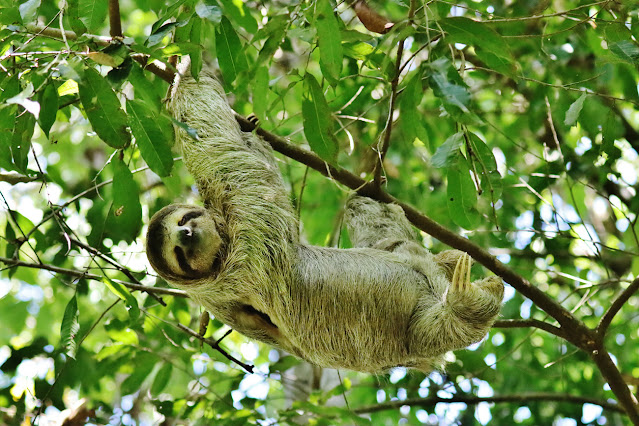 |
| Sloths are a popular sight in Manuel Antonio National Park. Photo by Brian Roth |
Lying in a hammock in a Costa Rican cloud forest, I listen
to a chorus of exotic birds singing unfamiliar songs. One squawks like a
peacock. Another sounds like it’s frantically telling a story. Then a
high-pitched whistle pierces the gusty air.
The sounds fill me with curiosity, even though I’m not a
bird enthusiast. But my 73-year-old father is obsessed with birds, which is why
I traveled with him to Costa Rica from Canada for eight days, along with my boyfriend
and mother.
 |
| The rare resplendent quetzal. Brian Roth photo. |
Now here we were, staying in a family cabin in the lush cloud
forests of Monteverde – one of Costa Rica’s premier birding destinations. It
feels surreal to finally be here. My father can’t stop smiling.
“There’s so many birds I haven’t seen before,” says my father after wandering around the hotel grounds with his fancy camera and long lens. His eyes sparkle with excitement. “I just love it here.”
 |
| Monteverde Cloud Forest Reserve. |
There are several private nature reserves in the region,
with the 10,500 acre Monteverde Cloud Forest Biological Reserve the most
popular. I decide to head to the less busy Santa Elena Cloud Forest Reserve as
my father goes searching for the famous, but rare resplendent quetzal – a
stunning tropical bird known for their long tails and canvas of bright colours.
Draped in a lush garden of mosses, ferns, flowers and
epiphytes growing on trees, walking into the Santa Elena Cloud Forest Reserve feels
like stepping into another world. The air is thick with moisture. The songs of
exotic birds and insects wafts through the forests that houses some monstrous
trees.
“How old do you think this tree is?” says Walter Bello, a naturalist
guide at the reserve.
 |
| Carara National Park. |
“Maybe 700 or 800 years old?” I reply, noting the enormous size of the tree.
“It’s maybe 100 years old. The trees here grow so fast they
don’t have rings,” says Bello, who points out a plant with spines emerging from
the trunk like the shield of a warrior.
Nearby, another plant grows from a tree top down to the
ground around another tree, slowly intertwining its roots to kill its host by
strangulation. Later, we spot an orange and black tarantula blending perfectly
into the dead leaves scattered on the ground.
Opening in March 1992, the Santa Elena Cloud Forest Reserve protects
765 acres of land and is permanently leased by the Santa Elena Community High
School, which originally intended on using the land for agricultural research
and education. However, the farming proved to be unsuccessful, so the land was
eventually converted into a cloud forest reserve, then later established for
ecotourism. An estimated 80% of all visitors come to Costa Rica for
ecotourism-related activities, providing a boost to local communities.
 |
| Playa Espadilla in Manuel Antonio. |
“Thanks to ecotourism, many people have an opportunity to economically grow and have access to better services for their families without a heavy impact on the natural resources,” says Bello, noting about 54% of Costa Rica’s land is covered by forest under a protection category. “It also opens the mind of local communities to grow out of the box, learn new language, cultures and useful skills.”
After two and a half days exploring the cloud forests of Monteverde,
we head for the intense tropical heat of Manuel Antonio along Costa Rica’s central
Pacific coast. The star attraction here is Manuel Antonio National Park, which
is the smallest national park in the country at 4,900 acres.
 |
| White-faced monkey. Photo by Mirko Freund. |
Beads of sweat drip from my forehead as my father and I gaze at smiling sloths sleeping high up in the trees. Near the park’s spectacular white-sand beach, white-faced monkeys swing effortlessly through the trees, entertaining tourists armed with cell phones. It’s another display of nature at its finest.
Seeing my father wandering around with a huge smile glued to
his face is heartwarming. Getting older seems to be sparking a desire to travel
to more exotic locations before it’s too late. I hope I can be there with him
to create more memories.
“So what’s next? Panama?” he says with a laugh. “The old guy is back in travel mode.”
WATCH: The magical forests of Monteverde and Manuel Antonio
IF YOU GO:
The thick vegetation in Costa Rica’s forests make it
difficult to spot wildlife that blends in perfectly to the surroundings. Hiring
a guide with a spotting scope is highly recommended if you want to learn about
the exotic plants, insects and see creatures hiding in the trees. Entrance
tickets for Manuel Antonio National Park can only be purchased online at https://serviciosenlinea.sinac.go.cr/
- Published by Go World Travel Magazine in December 2023: https://www.goworldtravel.com/costa-ricas-exotic-cloud-forests/
 |
| The Damas Island mangroves near Manuel Antonio provide great opportunities to spot wildlife. |